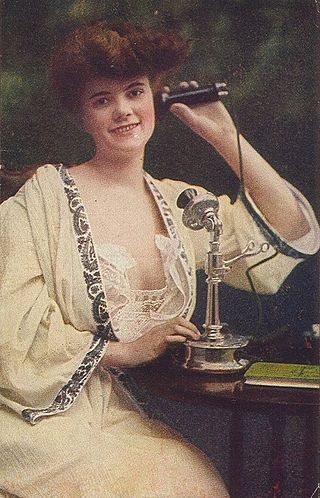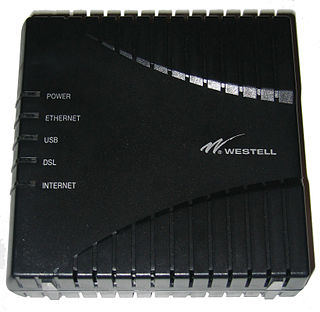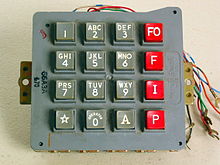
Dual-tone multi-frequency signaling (DTMF) is a telecommunication signaling system using the voice-frequency band over telephone lines between telephone equipment and other communications devices and switching centers. DTMF was first developed in the Bell System in the United States, and became known under the trademark Touch-Tone for use in push-button telephones supplied to telephone customers, starting in 1963. DTMF is standardized as ITU-T Recommendation Q.23. It is also known in the UK as MF4.
Plain Old Telephone Service (POTS), or Plain Ordinary Telephone System, is a retronym for voice-grade telephone service that employs analog signal transmission over copper loops. The term POTS originally stood for Post Office Telephone Service, as early telephone lines in many regions were operated directly by local Post Offices. For instance, in New Zealand, the telephone system remained under Post Office control until the 1980s.
A dial tone is a telephony signal sent by a telephone exchange or private branch exchange (PBX) to a terminating device, such as a telephone, when an off-hook condition is detected. It indicates that the exchange is working and is ready to initiate a telephone call. The tone stops when the first dialed digit is recognized. If no digits are forthcoming, the partial dial procedure is invoked, often eliciting a special information tone and an intercept message, followed by the off-hook tone, requiring the caller to hang up and redial.
Caller identification is a telephone service, available in analog and digital telephone systems, including voice over IP (VoIP), that transmits a caller's telephone number to the called party's telephone equipment when the call is being set up. The caller ID service may include the transmission of a name associated with the calling telephone number, in a service called Calling Name Presentation (CNAM). The service was first defined in 1993 in International Telecommunication Union – Telecommunication Standardization Sector (ITU-T) Recommendation Q.731.3.

A blue box is an electronic device that produces tones used to generate the in-band signaling tones formerly used within the North American long-distance telephone network to send line status and called number information over voice circuits. During that period, charges associated with long-distance calling were commonplace and could be significant, depending on the time, duration and destination of the call. A blue box device allowed for circumventing these charges by enabling an illicit user, referred to as a "phreaker," to place long-distance calls, without using the network's user facilities, that would be billed to another number or dismissed entirely by the telecom company's billing system as an incomplete call. A number of similar "color boxes" were also created to control other aspects of the phone network.

A silver box is a modified DTMF keypad that adds four additional keys. This gives four columns of four keys each instead of three columns.

A telephone keypad is a keypad installed on a push-button telephone or similar telecommunication device for dialing a telephone number. It was standardized when the dual-tone multi-frequency signaling (DTMF) system was developed in the Bell System in the United States in the 1960s – this replaced rotary dialing, that had been developed for electromechanical telephone switching systems. Because of the abundance of rotary dial equipment still on use well into the 1990s, many telephone keypads were also designed to be backwards-compatible: as well as producing DTMF pulses, they could optionally be switched to produce loop-disconnect pulses electronically.

A telephone call or telephone conversation, also known as a phone call or voice call, is a connection over a telephone network between the called party and the calling party. Telephone calls started in the late 19th century, initially relying on analog systems. As technology advanced, the majority of telephone calls moved from traditional landlines to cellular networks and mobile phones. Telephone calls have also become common over the internet, using Voice over IP (VoIP) technology. They are typically used for real-time conversation between two or more parties, especially when the parties cannot meet in person.
Call waiting is a telephone service where a subscriber can accept a second incoming telephone call by placing an in-progress call on hold—and may also switch between calls. With some providers it can be combined with additional features such as conferencing, call forwarding, and caller ID. Call waiting is intended to alleviate the need to have more than one telephone line or number for voice communications.
The Defense Switched Network (DSN) is a primary information transfer network for the Defense Information Systems Network (DISN) of the United States Department of Defense. The DSN provides the worldwide non-secure voice, secure voice, data, facsimile, and video teleconferencing services for DOD Command and Control (C2) elements, their supporting activities engaged in logistics, personnel, engineering, and intelligence, as well as other federal agencies.
In telecommunications, in-band signaling is the sending of control information within the same band or channel used for data such as voice or video. This is in contrast to out-of-band signaling which is sent over a different channel, or even over a separate network. In-band signals may often be heard by telephony participants, while out-of-band signals are inaccessible to the user. The term is also used more generally, for example of computer data files that include both literal data, and metadata and/or instructions for how to process the literal data.

A business telephone system is a telephone system typically used in business environments, encompassing the range of technology from the key telephone system (KTS) to the private branch exchange (PBX).
Message precedence is an indicator attached to a message indicating its level of urgency, and used in the exchange of radiograms in radiotelegraph and radiotelephony procedures. Email header fields can also provide a precedence flag.
The Automatic Secure Voice Communications Network (AUTOSEVOCOM) was a worldwide, switched, secure voice network for the United States Armed Forces, which was operational from the late 1960s to the end of the 1980s. It was closely related to the Automatic Voice Network or AUTOVON, which was the main non-secure switched telephone network for the military.
In telephony, call progress tones are audible tones that provide an indication of the status of a telephone call to the user. The tones are generated by a central office or a private branch exchange (PBX) to the calling party.

A digital subscriber line (DSL) modem is a device used to connect a computer or router to a telephone line which provides the digital subscriber line (DSL) service for connection to the Internet, which is often called DSL broadband. The modem connects to a single computer or router, through an Ethernet port, USB port, or is installed in a computer PCI slot.
In telephony, a special information tone (SIT) is an in-band international standard call progress tone consisting of three rising tones indicating a call has failed. It usually precedes a recorded announcement describing the problem.
Ringing tone is a signaling tone in telecommunication that is heard by the originator of a telephone call while the destination terminal is alerting the receiving party. The tone is typically a repeated cadence similar to a traditional power ringing signal (ringtone), but is usually not played synchronously. Various telecommunication groups, such as the Bell System and the General Post Office (GPO) developed standards, in part taken over by the European Telecommunications Standards Institute (ETSI) and other standards bodies. With modern cell phone and smartphone technology ringing tone can be customized and even used for advertising.

A telephone exchange, also known as a telephone switch or central office, is a crucial component in the public switched telephone network (PSTN) or large enterprise telecommunications systems. It facilitates the interconnection of telephone subscriber lines or digital system virtual circuits, enabling telephone calls between subscribers.
Dialling is the action of initiating a telephone call by operating the rotary dial or the telephone keypad of a telephone.









